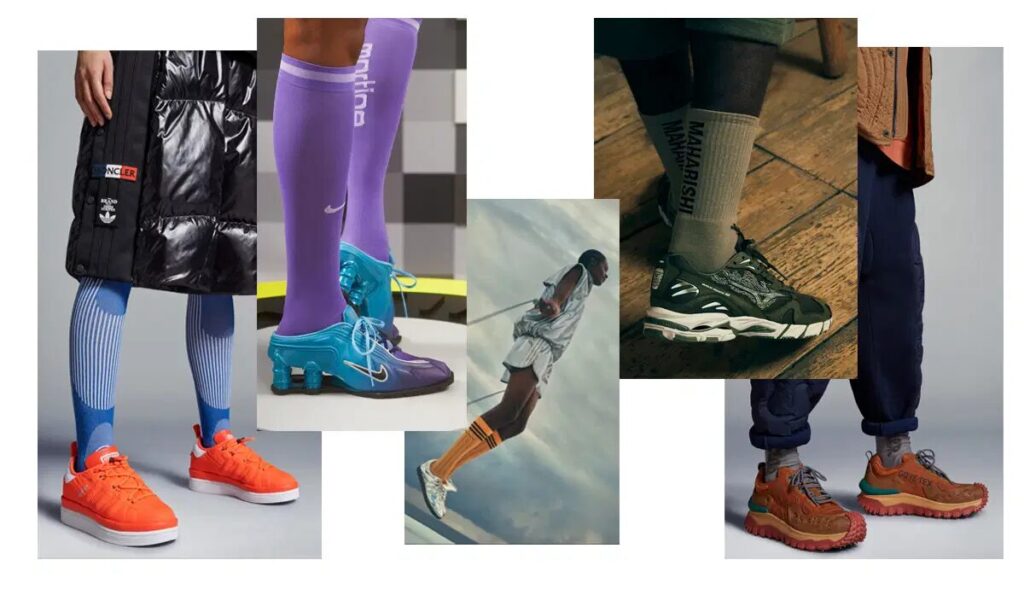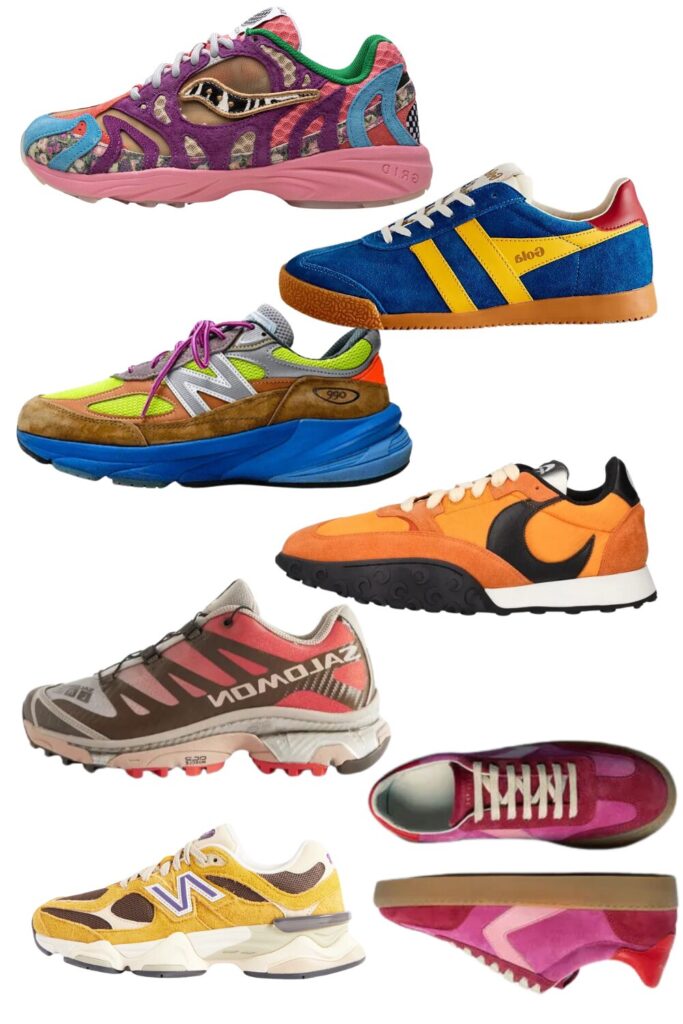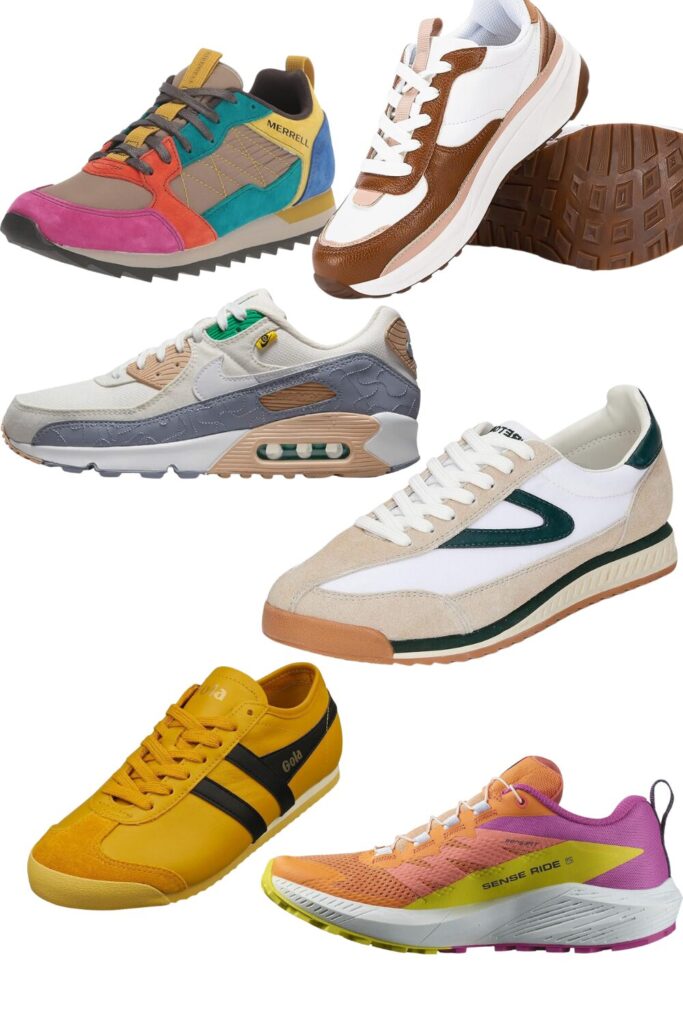
In the ever-evolving world of sneakers, what’s “in” one year can feel completely outdated the next. Yet, some trends have the ability to transcend time, consistently being reimagined and reintroduced in new forms. A perfect example of this phenomenon is the recent rise in popularity of multicolour, retro-inspired trainers. While neon colours once ruled the sneaker scene, the market is now overflowing with vintage-style kicks that combine nostalgia with modern flair. Fashion editor Remy Farrell, in a candid reflection on her evolving sneaker preferences, notes how her shift from neon to retro, tri-colour designs – such as the ones worn by influencer Monikh Dale – mirrors the broader movement towards revitalizing old-school aesthetics in footwear.
The Neon Era: A Sporty Revolution
Neon trainers have become a ubiquitous sight in fashion circles in recent years. The vibrant, eye-catching hues of neon yellow, green, pink, and orange were once associated with athletic wear, but over time, they became a staple in streetwear culture. Their prevalence in trainers stems from their inherent connection to sport – they feel fast, energetic, and youthful. Whether you’re hitting the gym, running errands, or walking down the high street, neon trainers make a statement that screams vitality and motion.
The popularity of neon trainers was fueled by their association with the 1980s and 1990s athleisure boom, which witnessed the rise of brands like Nike, Adidas, and Puma, all leaning into bold, high-visibility colourways. These brands pioneered the idea of using fluorescent colours in their athletic gear, and the look quickly transitioned from the track to the urban streets. As the lines between performance and fashion continued to blur, neon became shorthand for a sporty, active lifestyle.
However, in recent seasons, there has been a noticeable shift away from these vibrant, attention-grabbing hues towards more subdued, yet equally striking, retro-inspired designs. For many fashion insiders, the question is no longer about how bright the sneaker can be, but rather how it can blend vintage aesthetics with modern sensibilities. This shift is evident in the increasing interest in multicolour, vintage-style sneakers.
The Rise of Retro and Multicolour Trainers

The appeal of retro trainers is rooted in a sense of nostalgia. For many sneakerheads, the allure of these designs lies in the fact that they recall an era when trainers were simpler but still full of personality. These sneakers evoke memories of classic sportswear from the 70s, 80s, and 90s, but they do so in a way that feels fresh and relevant today. The resurgence of these multicolour trainers seems to be a reaction to the overwhelming dominance of minimalist and “clean” designs over the past few years, where neutral tones and sleek, monochrome silhouettes were the order of the day.
Multicolour trainers often feature contrasting panels of bold colours, mixing materials such as suede, leather, and mesh, and incorporating retro logos and motifs that remind us of sneaker culture’s golden age. These designs are an intentional nod to the past, yet they are reinterpreted for contemporary tastes with modern technology and construction techniques.
One such example, as mentioned by Remy Farrell, is the tri-colour New Balance sneakers worn by fashion influencer Monikh Dale. These shoes, with their blend of muted yet striking colours and vintage-inspired design, perfectly encapsulate the new wave of trainers that are equally suited to casual wear and fashion-forward styling. Their popularity is not a coincidence – they tap into the growing desire for sneakers that offer both style and comfort, while also offering a subtle connection to the past.
As sneaker brands continue to embrace this retro aesthetic, consumers are increasingly gravitating toward footwear that offers a sense of history and craftsmanship. New Balance, Nike, Adidas, and other iconic brands have capitalized on this trend by re-releasing classic models with updated materials and colours. For example, the New Balance 990 series, which debuted in the 1980s, has been reimagined multiple times in various colourways, including multicoloured designs that mix vibrant tones with more muted shades. These shoes, often associated with heritage, craftsmanship, and American design, have become a symbol of understated luxury within the sneaker community.
A Shift in Consumer Preferences

The growing demand for retro, multicolour trainers suggests a larger shift in consumer preferences. While neon trainers continue to be popular among those seeking boldness and visibility, there is a marked trend towards sneakers that offer a sense of history, craftsmanship, and nostalgia. The multicolour trend taps into the consumer’s desire for individuality, with each design telling its own story through the interplay of colours and materials.
For some, the appeal of retro sneakers lies in their versatility. Multicolour trainers, with their combination of vintage colour palettes and modern silhouettes, are easy to style with a wide range of outfits. Whether paired with jeans, joggers, or even skirts and dresses, these trainers add a dynamic touch to any look. Their ability to bridge the gap between casual comfort and fashion-forward styling makes them highly desirable.
Moreover, the retro trend aligns with the growing demand for sustainable and responsible fashion. As consumers become more aware of the environmental impact of fast fashion, many are turning to classic, durable sneakers that can stand the test of time. Vintage-inspired trainers, often made with high-quality materials, fit this ethos perfectly. Rather than chasing fleeting trends, sneaker enthusiasts are gravitating toward footwear that feels timeless and built to last.
The Influence of Sneaker Culture and Fashion Icons
The popularity of retro, multicolour trainers has also been propelled by the influence of fashion icons, athletes, and influencers. Celebrities and fashion figures, like Monikh Dale, have a powerful effect on the sneaker market. When Dale was spotted wearing her tri-colour New Balance kicks, it ignited a wave of interest in similar styles. This is a testament to the growing intersection between sneaker culture and high fashion, where sneakers are no longer just performance footwear but are an essential part of one’s overall aesthetic.
Social media platforms like Instagram and TikTok have further fueled this trend, with influencers and sneakerheads sharing their latest finds and styling tips. Hashtags like #sneakerhead and #sneakerfreak have created global communities of enthusiasts, all eager to show off their most coveted pairs. As these communities grow, so does the desire for unique, rare, or retro sneakers that allow individuals to express their personal style and connect with a larger cultural movement.
Additionally, collaborations between high-end designers and sneaker brands have played a significant role in pushing the multicolour, retro trend into the mainstream. Brands like Off-White, Balenciaga, and Sacai have partnered with Nike and Adidas, blending luxury fashion with the accessibility of streetwear. These collaborations often feature bold colour combinations and innovative designs, helping to elevate the status of multicolour trainers beyond the realm of casual wear into high-fashion territory.
The Future of Trainer Trends: Beyond Neon and Retro
As the sneaker market continues to evolve, it’s likely that we’ll see further experimentation with colour, material, and design. While neon and retro multicolour styles dominate the current landscape, the future of trainers may involve even more innovative blends of past and future aesthetics. Expect to see more futuristic takes on vintage designs, as well as technological advancements in shoe construction that make these trainers even more comfortable and durable.
One possible direction could be the integration of sustainable materials in multicolour trainers. As the fashion industry increasingly embraces sustainability, sneaker brands are likely to prioritize eco-friendly production methods and materials without sacrificing style. We might see retro-inspired designs made from recycled fabrics, biodegradable rubber, or vegan leather, allowing sneakerheads to indulge in their passion for trainers while also being mindful of the environment.
Conclusion
From the neon trainers of the past to the retro, multicolour designs of today, the evolution of sneaker trends has been both fascinating and dynamic. As fashion editor Remy Farrell highlights, the shift from neon to more subtle, tri-colour, vintage-inspired trainers is a reflection of the broader trend toward nostalgia and individuality in fashion. The rising popularity of these trainers speaks to the growing desire for footwear that tells a story, connects to the past, and can be effortlessly integrated into modern wardrobes. As the sneaker market continues to expand and evolve, one thing is certain: trainers are no longer just functional footwear, but a key element in shaping personal style and culture.
*Disclosure: This post may contain affiliate links, which means that I get a commission if you decide to make a purchase through my links, at no cost to you. Read my disclaimer for more info.


No responses yet